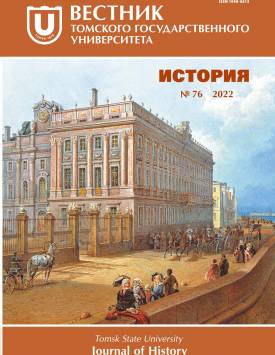Transformation of the Siberian peoples perception in historical context of Russian colonization from XVII Century to the beginning of XX century
During the process of Siberia colonization, the aboriginal peoples were being included into socioeconomic structure of the State and were developing into a special Russian tax paying estate, which special feature was the obligation to pay yasak - tax in furs. In Siberia the estate membership was the same with ethnic affiliation, not to a separate ethnos, but to all the aboriginal population. In XVII - XVIII centuries the most commonly used term to refer to the aborigines was “people”, “yasak [paying] people” or simply “yasachnye [literally, those who pay yasak]”. This affirmation could not become a basis for any kind of derogative or lordly attitude, thus eliminating any forms of xenophobia. It was the sequence of ambiguity in dichotomy “we-they” in minds of Russian people and authorities. The term “inorodets” [the one who was born somewhere else], or non-Slav was included into judicial practice after the implementation of “Non-Slav governing Statute” (1822). This term manifested non-Slav affiliation of the Siberian peoples, rather than non-Russian, and signalized the implementation of ethnic division in the Russian state judicial practice. But the definition “inorodets” or non-Slav was blurred and meant primarily belonging to the estate. Therefore, some groups of Russian settlers in Siberia were considered as “non-Slavs”. Such interest to the ethnic composition of the Empire was not only determined by the European ideas of nation state as a stage of nation development, or by developing freedom movements in German and Slavic-speaking peoples of Europe, but also by the development of Russian national identity which developed later into Slavophilism. The consequence of Evolutionism ideas proliferation among the educated Russian nobility was the identification of Siberian peoples with the early stages of mankind development. The archak nature of the way of living of Siberian peoples led to the understanding of their lifestyle as that of at the early stages of development. By the second half of XIX - beginning of XX century the composition of Russian settlers had changed: they did not have any inter-ethnic contacts experience, the culture and lifestyle of Siberian peoples provoke misunderstanding among Russians, and agricultural tensions resulted in conflicts. Eurasian image and Russian mentality features had been gradually blurring, and thus the perception of aboriginal peoples changed from neutral “the peoples” through ambivalent “inorodets” to the image of savages which led to attitude of dislike, lordliness and even disparaging to them.
Keywords
aboriginal policy in Siberia, Siberian ethnos, fur tribute, non-Slavs, Slavophilism, modernization processesAuthors
| Name | Organization | |
| Sherstova Lyudmila I. | Tomsk State University | sherstova58@mail.ru |
References

Transformation of the Siberian peoples perception in historical context of Russian colonization from XVII Century to the beginning of XX century | Tomsk State University Journal of History. 2022. № 76. DOI: 10.17223/19988613/76/19
